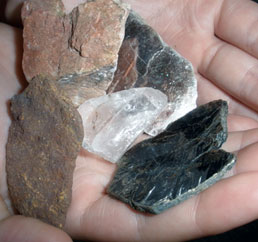4. Mineral Materials

It’s easy enough to measure the volume of a liquid if we have a measuring cup, but how do we measure the volume of solid materials — especially if they are oddly shaped, like a rock or a handful of soil? It’s an ancient problem, and one that students examine first, like the ancient Greek mathematician Archimedes, through a consideration of water displacement.
Students first investigate what happens when a rock is submerged in water, and determine that it is volume, not weight, that causes the water level to rise. Then, through a series of hands–on investigations, they find ways to measure the volumes of rocks, gravel, and sand.
As the investigations unfold, students come to understand that two objects cannot occupy the same space at the same time. They discover that the volume of a solid object can be found by water displacement, observe that the volumes of objects can be added, and consider how the volumes of granular materials are different from the volumes of liquids and solids.
Investigations:
- 4.1 What causes the water level to rise?
- 4.2 How can we measure the volumes of rocks?
- 4.3 What happens when we add earth materials to water?
The Child and the Scientist

The Child:
The Challenges in Learning about Water Displacement

The Scientist:
What does “Eureka” mean? Displacement of liquids
Concept Cartoon

The Volume Concept Cartoon is typically used after Investigation 4.3, What happens when we add earth materials to water?.





